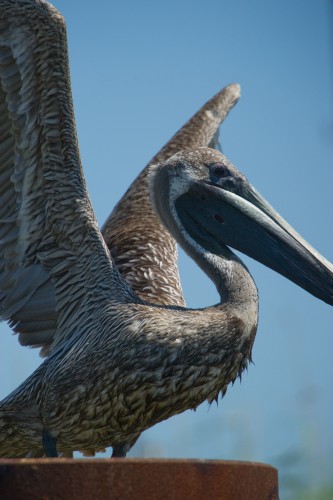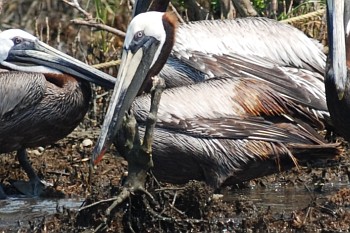
Gretna, Louisiana, 2:00 a.m.
As oil moves ashore in Louisiana, its effects on birds are becoming more visible to us humans. Yet this remains a slow-motion disaster, and while some birds are discovered coated heavily with oil, many others are lightly oiled, mobile, but compromised and likely dying. Here's what we're seeing in the field:

Partly oiled immature Brown Pelican (Kim Hubbard/Audubon Magazine)
The young Brown Pelican pictured above has swum through oil, coating its breast and belly feathers, which now look stringy and spiky. This puts the bird in danger for several reasons:
- - Oiled feathers lose their insulating properties, so the bird is more vulnerable to hypothermia (in the water or the rain) and hyperthermia (in the sun and hot temperatures).
- - Oiled feathers cannot protect the bird's skin from the sun, leaving it vulnerable to sunburn.
- - Oiled feathers don't repel water properly, interfering with a bird's ability to function in an acquatic environment.
- - The bird will try to preen out the oil with its bill and in so doing could inadvertently swallow oil, which is toxic and would damage its internal organs.
Some very lightly oiled birds may recover on their own, but for these reasons and others, even small amounts of oil on their plumage can slowly kill birds.

Partly oiled adult Brown Pelican -- note brown staining toward rear of bird's body. (David J. Ringer/Audubon)
Pelicans are very likely to contact oil because they feed by plunging into gulf and bay waters after fish. We have known for some time that pelicans in Louisiana's breeding colonies are coming into contact with oil; however, mounting rescue operations would disrupt entire colonies, putting state and federal officials in the agonizing position of leaving some birds to suffer so that the colonies have a chance to produce at least some young this year.
Today, an Audubon field team surveyed two nesting islands in Barataria Bay, and we did indeed find many oiled pelicans at the peripheries of the colonies. Most of the birds showing oil were oiled on their breasts and bellies like the immature bird pictured above.

Today, less than 24 hours after Louisiana governor Bobby Jindal publicly castigated BP for not providing boom to protect these specific nest colonies, we encountered crews laying boom around them. Vegetation and birds are already oiled. While all efforts are to be applauded, booming will not protect pelicans, which encounter oil when they fly out into open waters to feed. (Kim Hubbard/Audubon Magazine)
Pelicans weren't the only oiled birds on the islands. We also observed several oiled Laughing Gulls and several oiled White Ibises. Great Egrets, Roseate Spoonbills and Tricolored Herons were nesting too, but we didn't observe oil on any of them; they were, however, toward the interior of the colonies and much harder to see clearly. (We've also seen oil on shorebirds.)

White Ibis stained heavily by oil. The white barrier is absorbent boom, deployed by parish officials in a desperate bid to protect these islands and their birds. (Kim Hubbard/Audubon Magazine)

Brown Pelican chicks. (Kim Hubbard/Audubon Magazine)
Painful as it was to see so many birds distressed by oil, there were also signs of hope -- at least for now. The majority of pelicans appeared unaffected. Some pelican chicks have hatched and are in various stages of development.
But this disaster is really just getting underway, and oil will be present in these birds' environment for a long, long time to come. Right now it appears inevitable that more and more birds will come into contact with oil, and that many of those that do will gradually weaken and die.
When I close my eyes tonight, I will see a Brown Pelican, its belly coated with oil, preening relentlessly, in a desperate and futile attempt to remove the oil coating its feathers. For this bird, preening has become an obsession. It snaps its bill across across its breast over and over and over, unable to right the wrong but not knowing what else to do -- in human terms, a descent into nightmare, or even madness.

An oiled Brown Pelican preens relentlessly, compelled to clean itself but powerless to do so. (Kim Hubbard/Audubon Magazine)
